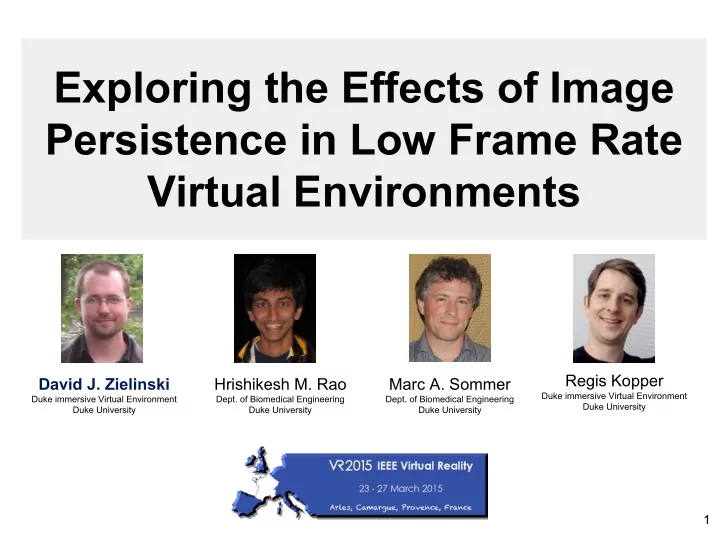

Exploring the Effects of Image Persistence in Low Frame Rate Virtual Environments Regis Kopper David J. Zielinski Hrishikesh M. Rao Marc A. Sommer Duke immersive Virtual Environment Duke immersive Virtual Environment Dept. of Biomedical Engineering Dept. of Biomedical Engineering Duke University Duke University Duke University Duke University 1
Why Low Frame Rates? Input Device Update Rates Drones get GPS updates at ~9hz. (Pitman 2012) Computational Load All-atoms contact takes time to calculate. (Davis 2004) Scene Complexity Reducing visual complexity impacts training. ( Ragan 2015) 2
Low Frame Rates May Cause... Increased simulator sickness (Zielinski 2013) (Kolasinski 1995) Decreased task performance (Ellis 1997) (Ware 1994) Decreased presence (Meehan 2002) (Barfield 1995) 3
Can We Interpolate to a Higher Frame Rate? Modern TV Interpolation (Wang 2010) - Interpolation introduces frame delay (thus latency) - Has artifacts - “soap opera effect”. Warping with Prediction (Smit 2010) - Store computed image with per pixel depth values. - Predict head motion to make warped in-between images. - Has artifacts - missing pieces / holes. Oculus Rift “Time Warp” (Carmack 2014) - Right before we display, warp using latest tracking data. - Useful with high frames rate where views are similiar. - Low frame rate conditions likely to show artifacts. 4
Persistence With Low Frame Rates Issues: HP multiple “phantom lines” artifacts for moving objects 5
Persistence With Low Frame Rates Issues: HP multiple “phantom lines” artifacts for moving objects, LP has strobing effect. 6
Let's Observe the Artifacts 7
Previous Low Persistence Work Sports Training ( Appelbaum 2013) - Stroboscopic glasses utilized during sports training - Improved some visual and attention abilities. - However, not same paradigm as our shutter glasses. ie, glasses were 100ms open, then various closed times. Strobe Lighting / Shutter Glasses ( Reschke 2006 ) - Both lead to reduction in nausea vs control. Oculus Low Persistence - Low persistence techniques in a high frame rate condition - Seems to improve visual experience. 8
Experimental Display Conditions Notes: Simulated HP/LP to remove input latency. 9
Experiment Setup ● 6-sided CAVE-type system ● Active Stereo ● Intersense IS-900 tracking ● Took place over 3 days. ● Fully crossed within-subjects ● One display method per day ● 22 participants,18 completed 10
Selection Task ● Ray-casting selection based on the ISO9241-411 standard. ● On successful trigger click, target hidden, next target revealed. ● Sequence: 75 large targets, then 75 medium, then 75 small. 11
Selection Results HFR significantly faster (p < .0001) than HP and LP No significant difference between HP and LP. 12
Navigation Task ● Navigation down a hallway utilizing xBox gamepad ● Each trial had different path width. (large, then medium, then small) ● When the user went off the path, the floor was highlighted in green and the maximum speed was reduced (to provide incentive to stay on the path). 13
Navigation Results Path Width vs Display Method HFR significantly faster than LP (p < .05) and HP (p < .005) 14
Simulator Sickness (SSQ) ● Overall SSQ showed no significant results ● Oculomotor subscore LP significantly greater than HFR (p < .05) ● Individual nausea question showed HFR marginally greater than HP (p=.084) ● Severe nausea (2 subjects) was only during HFR condition. We expected HFR to have the lowest nausea. Perhaps… 1) Increased optical flow (Yin 2009) 2) Our persistence simulator artificially reduced input latency which is normally present in low frame rate cases. 3) Some users reported looking at the floor Perhaps consider the PenguFly ring task to focus attention forward. 15
What (if any) VR Tasks Benefit From Low Frame Rate LP? For future work we would like to test targets that are in motion. 16
Thank You! Questions? Comments? David J. Zielinski djzielin@duke.edu http://www.duke.edu/~djzielin/ 17
Recommend
More recommend